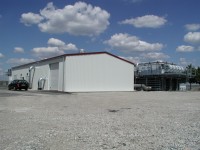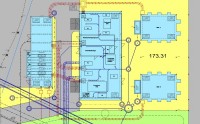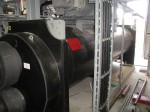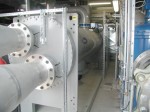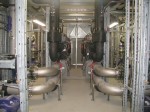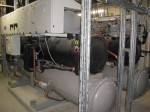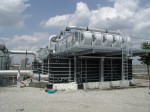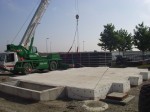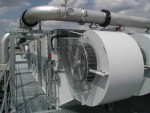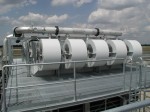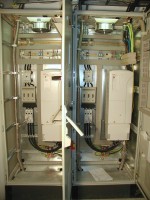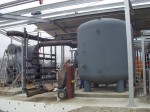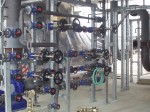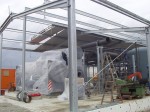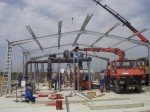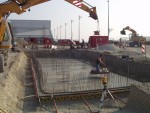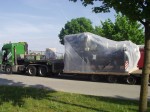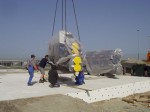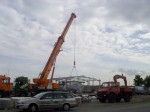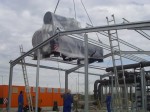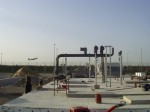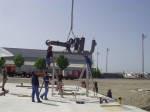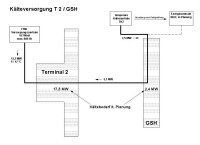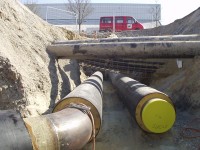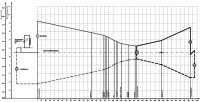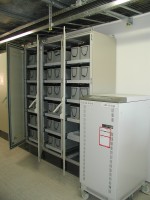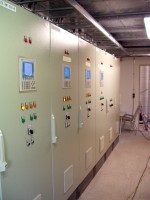Construction of a temporary district cooling station (TKZ) for Terminal 2 and luggage sorting facility
Munich Airport Franz Josef Strauss
You may also get informed about our experience with
Would you like to get to know more about us?
Please have a look at our company profile, our services and feel free to get in contact with us.
Table of content
Project data
| Planning and realization period: | 2001..2003. |
| Project size | 2,7 mio. € |
| Client: | Generalplaner Technik Ingenieurgesellschaft mbH Flughafen Muenchen Terminal 2 (CBP + b.i.g.) |
| Consultant: | Planning consortium IB W. Roegelein, VBI, Munich Regierungsbaumeister Schlegel GmbH, Munich |
Engineering services
Planning of district cooling generation in the area of Ramp 3 for peak cooling supply of Munich Airport Terminal 2 and luggage sorting facility.
Services according to HOAI, Part IX - Technical Equipment - § 73, phases 2 to 8, consisting of:
- Preliminary and blueprint planning
- Approval planning
- Implementation planning
- Tendering procedure
- Site management
Project information
In the course of new building of Terminal 2 and luggage sorting facility the district cooling supply of Munich Airport has been extended.Since during the planning phase it had been revealed that the district cooling demand of Terminal 2 and luggage sorting facility exceeds the supply capacity of the existing supply station west during peak load times, a new district cooling supply station with the following characteristics has become necessary:
- 1 x turbo refrigerator Q0=5,0 MW
Refrigerant R134a
Pel=936 kW
Qcond=6,7 MW
Motor 6,3 kV
Cold water 4,5°C/15,5°C
Cooling water 27°C/33°C
- 2 x screw type compressors, Q0 = 1,25 MW each
Refrigerant R134a
Pel=232 kW
Qcond=1,47 MW
Motor 0,4 kV
Cold water 4,5°C/15,5°C
Cooling water 27°C/33°C
- 2 x open wet cooling towers, Q = 5,9 MW each
flat construction with radial ventilation
water reservoirs warm/cold with appx. 64 m3 each
Cooling water max. 840 m3/h
controlled by frequency converter, engine 75 kW
- Cold water pressure maintenance with surge tank 17 m3
"District Cooling Leasing"
In order to reduce the risk of investment, the forementioned cooling water sets were leased for several months in the period 2003 with the option to buy them.
The district cooling generators are aligned in a light weight construction hall which allows for the rearrangement of the cooling sets in a new environment should Munich Airport be extended furtherly.
Special characteristic: Very short building time
- Start of errection of the base plate: March, 17th 2003
- Begin of setting up the facilities on the site: May, 5th 2003
- District cooling delivery on opening of Terminal 2 by TKZ: June, 27th 2003
This challenging timeline could only be realized due to pre-crafting of facility elements by the implementing company
Extension of the district cooling network
With setting up the Temporary Cooling Station a multiple injection is realized into the district cooling network of Munich Airport for mixed operation with medium pressure attitude.
This measure includes an interconnection pipe from Terminal 2 via HVAC apron tunnel to the Luggage Sorting Facility in a diameter of DN 300. This district cooling pipe serves the supply of the apron hall in the case of low demand, as well as a partial coverage for Terminal 2 by design criteria.
Die Fernkälteversorgung der Gepäcksortierhalle Vorfeld kann aus hydraulischen Gründen nur während der Schwachlastzeit aus der bestehenden Versorgungszentrale West (Zone 145.0) als Teilversorgung sichergestellt werden. Für eine Vollversorgung während der Hauptlastzeit ist die Temporäre Kältezentrale erforderlich.
Die Möglichkeiten der Schwachlastkälteversorgung durch die Versorgungszentrale West mit dem angeschlossenen Fernkältenetz sollen ausgeschöpft werden, da in dieser Anlage Fernkälte umweltverträglich erzeugt wird, und zwar:
- bei niedrigen Außentemperaturen durch sogenannte "Freie Kühlung" in Verbindung mit dem bestehenden Rückkühlwerk VZ West.
- zur Grundlastdeckung mit Absorptionskältemaschinen, die ihre thermische Antriebsenergie aus dem Kraft-Wärme-Kopplungsprozeß der BHKW-Anlage beziehen.
Im Falle der oben beschriebenen Betriebsweise im Kälteverbund entsteht ein zusammenhängendes, gemeinsames hydraulisches Kreislaufsystem mit durchgängiger Mitteldruckhaltung, welche durch identische Fremddruckanlagen in der VZ wie auch in der TKZ erzeugt wird.
Hauptversorgung durch VZ West sowie Stützbetrieb durch TKZ
Der Auslegungsfall ist dadurch gekennzeichnet, daß die von der TKZ maximal erzeugte Kälteleistung in Höhe von Q0=7,5 MW in Form von Kaltwasser 5°C durch das Fernkälte-Verbundnetz durch den Koppelverteiler in der Gepäcksortierhalle hindurch in Richtung Westen in die FK-Hauptverteilung des Terminal 2 eingespeist wird.
Am Koppelverteiler wird der Kältebedarf für die GSH abgenommen.
- FK-Bedarf GSH max. 2.400 kW (Klimakaltwasser 5°C/18°C)
- FK-Restbedarf T2 max. 5.100 kW (Klimakaltwasser 5°/17,2°C)
Hierbei liegt ein mit 860 t/h begrenzter FK-Massenstrom mit einer rechnerischen Temperaturspreizung von 5°C/17,2°C zugrunde. Der fehlende Kaltwasserstrom wird durch die TKZ über den Koppelverteiler in die Fernkälteverteilung von Terminal 2 eingespeist.
Schwachlastfall - Übergreifende Fernkälteversorgung durch VZ West
Soweit der Schwachlastbedarf von Terminal 2 und Gepäcksortierhalle durch VZ West gedeckt werden kann, ist die TKZ außer Betrieb. Die Fernkälteversorgung durch VZ West gilt solange als gesichert, als am Koppelverteiler in der Gepäcksortierhalle ein bestimmter Mindestdifferenzdruck (z.B. 1.500 mbar) eingehalten werden kann.
Die Versorgungskapazität von VZ West soll im Hinblick auf die dort angewandte effiziente Kraft-Wärme-Kälte-Kopplung (KWKK) weitgehend ausgeschöpft werden.
Druckhaltung im Verbundbetrieb von VZ West und TKZ
Der Haltedruck, welcher sowohl in VZ West als auch in der TKZ durch Pumpen auf das Fernkältenetz aufgeprägt wird, soll im Verbundbetrieb durch VZ West als analoges Leitsignal der TKZ vorgegeben werden.
Betriebsart in der Erprobungsphase
Während der Inbetriebsetzung besteht die Möglichkeit einer Netztrennung, so daß der Versorgungsbereich von TKZ auf Gepäcksortierhalle und Pier Süd (von Terminal 2) begrenzt wird. Die übrigen Kälteverbraucher werden dann durch VZ West versorgt.
Leittechnik, Automation
Abschnitt in Vorbereitung
